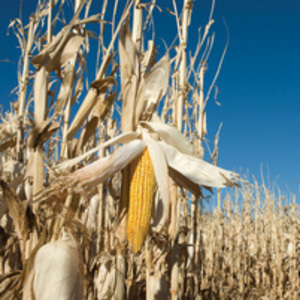Continued strong exports reduces project corn ending stocks

April 9, 2014
BY Susanne Retka Schill
USDA reduced projected U.S. corn ending stocks for 2013/14 by 125 million bushels based on the projected increase in corn exports. In its monthly World Agriculture Supply and Demand Estimates released April 9, USDA reported continued strong export sales and a rising weekly shipment pace for U.S. corn during March as supporting the higher expected export level along with an increase in projected global corn demand.
No changes were made to the projected use of ethanol, which had been pegged at 5 billion bushels in the last monthly report, compared to an estimated 4.65 billion bushels used in 2012/13 and 5 billion in the previous marketing year.
The 2013/14 season-average farm price for corn is raised 10 cents at the midpoint with the projected range also narrowed to $4.40 to $4.80 per bushel, compared with $4.25 to $4.75 per bushel last month. The projected range for the sorghum farm price is also raised 10 cents to $4.15 to $4.55 per bushel. Sorghum exports are projected 20 million bushels higher based on the high level of outstanding sales and the sharp increase in weekly shipments during March. Sorghum ending stocks, however, remain unchanged with an offsetting reduction made in domestic use based on the higher-than-expected March 1 stocks estimate.
Advertisement
Advertisement
Global corn production is raised 6.4 million tons with a 2.0-million-ton increase for Brazil and 1-million-ton increases each for South Africa and Russia. For Brazil, favorable precipitation in March and early April has supported the developing safrinha corn crop (the second corn crop) with yields now expected just below last year’s levels in the areas where this second-season corn crop is grown. For South Africa, improved rains in late February and March have boosted yield prospects for corn grown in the normally lower-yielding western areas. Corn production is raised for Russia based on recent revisions to official production statistics. Corn production is also raised 0.2 million tons for Mexico, in line with the latest government estimates.
Global sorghum production is lowered 1.1 million tons mostly on changes to the sub-Saharan Africa countries, but production is also lowered 0.4 million tons for Argentina and raised 0.3 million tons for Brazil.
Corn imports are increased for the European Union, Algeria, Iran, Egypt and Vietnam. In addition to the United States, corn exports are increased for South Africa, Ukraine, Mexico, Russia and Vietnam and sorghum imports are raised for China.
Advertisement
Advertisement
Global corn consumption is higher with increases in feeding for Argentina, Russia and Algeria. A reduction in European Union corn feeding is more than offset by an increase in food, seed and industrial use. Corn use is also raised for several of the sub-Saharan Africa countries led by increases of 1 million tons for Uganda and 0.9 million tons for Ethiopia. World corn ending stocks for 2013/14 are lowered 0.5 million tons with reductions for the United States and Ukraine outweighing increases for Brazil, Russia, and several other countries.
To view the complete April 9 WASDE report, click here.
Related Stories
The U.S. EPA on July 8 hosted virtual public hearing to gather input on the agency’s recently released proposed rule to set 2026 and 2027 RFS RVOs. Members of the biofuel industry were among those to offer testimony during the event.
The USDA’s Risk Management Agency is implementing multiple changes to the Camelina pilot insurance program for the 2026 and succeeding crop years. The changes will expand coverage options and provide greater flexibility for producers.
The USDA’s National Agricultural Statistics Service on June 30 released its annual Acreage report, estimating that 83.4 million acres of soybeans have been planted in the U.S. this year, down 4% when compared to 2024.
SAF Magazine and the Commercial Aviation Alternative Fuels Initiative announced the preliminary agenda for the North American SAF Conference and Expo, being held Sept. 22-24 at the Minneapolis Convention Center in Minneapolis, Minnesota.
Scientists at ORNL have developed a first-ever method of detecting ribonucleic acid, or RNA, inside plant cells using a technique that results in a visible fluorescent signal. The technology could help develop hardier bioenergy and food crops.
Upcoming Events










